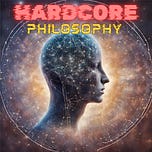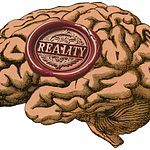This is a follow up to a previous post, Do we know minds through behavior? Here I’d like to explore a couple of theories about how we might come to know our own boundaries of selfhood to see whether they clarify our understanding of other minds.
Where do I end and you begin?
PHYSICAL BOUNDARIES
Maybe we can define the boundaries of self as something extended in space and time. I’m located here and you’re over there. You can’t be me because you aren’t located when and where I am.
Unfortunately, this presupposes the boundaries it purports to pick out. What, exactly, is located here vs. there? You might have decided your self is your brain or your body, but then why? Physical location requires knowing what we’re locating. Which means we’ve gone in a circle.
You might think there’s no need to locate a self, since there is no such thing:
"There's no reason to suppose that we have real continuity. Because if you look at what a body and a brain are, there's no room for a thing called a 'self' that sort of sits in there and has experiences…The illusion of continuity is created only when you look for it. Though all things about us change from moment to moment, when we connect all of our experiential dots, we conjure up our inner sense of self. …This so-called 'me' is really just another reconstruction. There was an earlier one 30 minutes ago, and there will be others in the future. But they're really not the same person; they're just stuff happening in the universe."
Susan Blackmore, Is Your 'Self' Just an Illusion?
From a purely physical point of view, she’s right; the self can only be “just stuff happening in the universe”. The same is true of life, though, when you think about it. We presuppose our intuitions of what life is when we say life “emerges” out of its parts. If we didn’t have a prior conception of life, we wouldn’t see anything emerging.1
“Life is the vaporware of chemistry: a property so obvious in our day-to-day experience—that we are living—is nonexistent when you look at our parts. If life is not a property of matter, and material things are what exist, then life does not exist.”
“Life does not exist”: The deceptively tricky task of defining life
From a strictly physical reductive perspective, there is no such thing as life. To differentiate living things from non-living things, a different kind of explanation is needed. The same is true for the self, although selfhood could prove even more elusive and difficult to identify.
SUBJECTIVE BOUNDARIES
AGENCY: Agency is probably the most powerful theory of self. Not only is it intuitive, it also picks out what it is that makes me me in the physical world as well. I can literally see my agency at work every time I will my finger to move. But I can't move your body just by willing it; I can only move my own (to some degree). What makes my body mine might be discovered by my agency realizing its own powers and limitations. Just as I can’t control your body, I can’t control your thoughts, only my own (to some degree). Where my agency ends, my self ends. That’s where you or the physical world begin.
Our motives and intentions go beyond arbitrarily coinciding with our physical bodies or emerging from it like a mist. We cause our own behavior. Limits to our range of agency define our selfhood boundaries. Pushbacks against the agent’s power come from the world with its physical laws as well as other agents with their own ranges of power over their own bodies.
One problem with the agency theory is that the boundaries that make me me are not as sharp as we tend to think. If I can successfully drive a car, does that mean the car is part of me? If I get you to sign my petition, did my influence over your behavior mean you are in some sense under my control and therefore…me? Maybe we can dispense with this problem by saying agents don’t always drive machines or exert total influence over others, so these are not essential to the agent. But what is essential? If selfhood requires permanent control, that’s a problem too, since it’s not clear that I permanently control much of anything. It seems to me agency alone leaves our selfhood boundaries fuzzy. Maybe that’s okay.
UNITY: Immanuel Kant’s transcendental unity of apperception is one of the more sophisticated theories of self. This will take some explaining.
Apperception means something like self-reflection or self-consciousness. Transcendental here refers to a kind of argument for which Kant is well known which goes: ‘x is a condition for the possibility of y’. Putting those two together, we get: the transcendental unity of apperception is a deductively necessary2 condition for the possibility of experience.
I know this is a lot to take in. I’ll try to explain Kant’s theory by bouncing it against Susan Blackmore’s view quoted at the beginning:
“There's no reason to suppose that we have real continuity. Because if you look at what a body and a brain are, there's no room for a thing called a 'self' that sort of sits in there and has experiences…”
She takes the real self to be the self as it is in itself; in other words, the self is nothing more than its objective physical manifestation, which she assumes to be the brain and body. Whereas Kant is far more minimalist; he says we can’t even know that much. The Kantian self is an “I” that unifies all of my representations—and nothing more. We can’t know its properties (whatever the hell a “property” is). We can’t know whether it’s a physical substance like a brain or spiritual substance like a soul. These claims, according to Kant, go beyond the limits of reason because they take the self to be a thing in itself. Things in themselves are entirely beyond our reach.
Blackmore goes on to say:
“The illusion of continuity is created only when you look for it. Though all things about us change from moment to moment, when we connect all of our experiential dots, we conjure up our inner sense of self. …This so-called 'me' is really just another reconstruction. There was an earlier one 30 minutes ago, and there will be others in the future.”
Perhaps Kant would say that Blackmore’s missing an important point: even if we do merely “conjure up” an inner sense of self, this act necessitates standing outside all of those disconnected experiences to judge them all at once as a unity. Any attempt to stand apart from experiences to judge them to be discontinuous thereby unifies them, which precludes their really being discontinuous. Some minimal unifying “I” must always be there even if it’s nothing more than a container, even if its contents are a mere jumble of snapshot reconstructions. The truth is, we don’t experience some buzzing swirling jumble of qualities. We experience things united in selfsame objects, even if they have many different qualities. So in a sense, everything we experience is a pre-construction. This speaks to Blackmore’s point that you only find unity when you go looking for it; Kant argues you must find unity every single time you go looking for it because it is the very thing makes experience possible. And anything that makes experience possible cannot be dispensed with by reason.
Blackmore’s points aren’t too different from arguments involving split brains and multiple personalities which are meant to prove the disunity or illusory nature of the self. These arguments, which are far from conclusive on other grounds, don’t speak to the Kantian theory of self at all. They confuse the particular contents of experience with the container—or to put this in Kantian terms, they go beyond the limits of our understanding—and then erroneously conclude the self doesn’t exist or it’s just a convention. In doing so, they forget to take their own judgment into account. Whatever stands back from the various reconstructions to judge the self to be illusory must itself be an illusory reconstruction, which makes the position self-undermining. By contrast, Kant’s argument for the transcendental unity of self takes whatever it is that’s standing back into account, and does so without making metaphysical claims about the self. It’s a svelte theory, and it’s about as hard to deny as Descartes’ cogito.
Both phenomenological conceptions of the self ring true to me on some level. Agency for its experiential obviousness and explanatory power and Kant’s for its minimalism and logical rigor. Yet I’m noticing that both theories begin by taking the isolated subject as the starting point. Agency begins with me first, and Kant insists we can only know the way things seem, not the way they are independent of our minds…not even our selves (much less other minds!)
I’d like to take a more relaxed approach by examining lived experience. “The real world” is, after all, where Cartesianism goes to die, and that seems promising. I’m sure our sloppy, everyday intuitions will fall far short of Kant’s brilliant transcendental deductions, but we’ll just have to make do. This is what I’ll talk about next time.
The music in this podcast episode is by Nick Herman. Discover his music on Bandcamp. Support indie artists!
You can customize which bits of this newsletter you receive by visiting your account.
Thanks for supporting my literary endeavors and off-beat philosophical speculations. Cheers!
—Tina
“From the side of insentient matter the gulf that separates it from sentience is infinite; no bridge can reach the other bank…as it happens, a substratum linking insentience to sentience does exist; depending on the level of reality on which the question is raised, it is form, existence, being, or the Infinite. But nothing answering to the physical categories links the terrestrial plane to those above.”
—Huston Smith, Forgotten Truth
“Any coherent part of the organism is indeed puzzling to physiology and also meaningless to pathology until the way it benefits the organism is discovered. And I may add that any description of such a system in terms of its physical-chemical topography is meaningless, except for the fact that the description covertly may recall the system's physiological interpretation—much as the topography of a machine is meaningless until we guess how the device works, and for what purpose.
…if the structure of living things is a set of boundary conditions, this structure is extraneous to the laws of physics and chemistry which the organism is harnessing. Thus the morphology of living things transcends the laws of physics and chemistry.”
—Michael Polanyi, Life’s Irreducible Structure
The proper terminology here is: “the a priori condition for the possibility of experience”.















Share this post